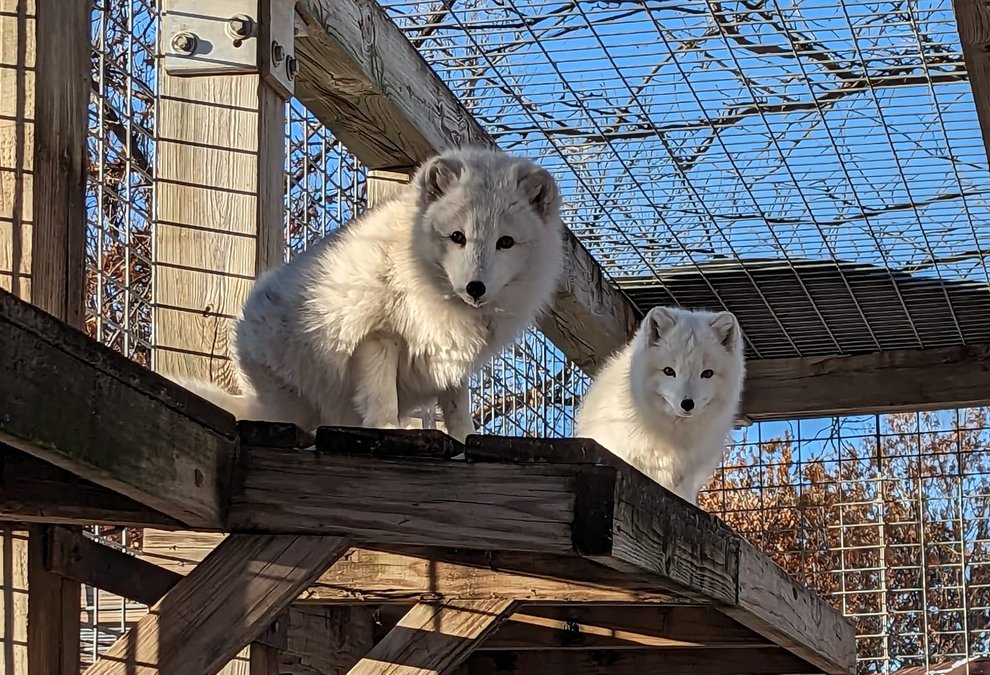

The extreme cold this week has been hard on animals as well as humans, from the family dog to the leopard at the Great Bend Brit Spaugh Zoo. We heard from Zoo Supervisor and Animal Curator Ashley Burdick as well as from an animal expert at PetSmart with information about animal care in the cold.
Zoo closed
Due to the extreme cold and the Christmas holiday, Great Bend’s zoo was closed Thursday, Dec. 22, and will remain closed through Christmas Day. However, zookeepers are there every day tending to the animals.
Cold weather precautions
“Whether we’re talking about pets or the zoo animals, if you can bring them inside that is the best option,” Burdick said. “We brought everyone inside except for the arctic foxes and the bison. Those two species have shelters provided and straw bedding they can use if they choose.
“The foxes were in their dog houses Thursday, but they were napping outside this morning,” she said on Friday. “For all the animals inside we have heated buildings. We also provide straw bedding to those animals that don’t have elevated beds or hammocks.”
Frozen water is also an issue for animals.
“Since many of the water hydrants are frozen, we have to bucket water for drinking and we aren’t able to clean as well as we would when it’s warmer, but we get as much as we can.”
Zookeepers also have to prepare for the potential of power outages, which comes with its own set of challenges, Burdick said. “We have multiple buildings with generators or the ability to hook one up so we can move as many smaller animals as possible. For the animals like bears, or big cats, we just give them deep straw beds and we would rotate gas-powered generators to provide heat to those species. We also have contingency plans in place for water, food, etc.”


Tips for pets
This week we’ve prepared our cars, homes and families for extreme weather. It’s also important to remember pets’ needs this time of year. Jennifer Bruns, D.V.M., M.P.V.M. at PetSmart, shares tips on how to ensure your pets are warm and happy throughout this winter storm and full winter season.
• Limit outdoor walks and activities.
Letting your dog outside to use the bathroom or go for a quick walk is okay, but never leave a pet outside for a long period of time, especially during a winter storm or extreme cold.
• Add extra layers.
Pet sweaters aren’t just for fun, they also help to keep your pet warm. If your pet is shivering, that’s a sign they need some extra layers like a sweater or coat. To help keep in body heat and protect their paws from the extreme cold as well as salt and ice, consider using booties on paws when venturing outside.
• Watch out for hazardous chemicals.
Many people use snow-melting products like deicers, antifreeze and salt which can cause skin irritation, and if ingested by your pet, can be fatal. After a walk, it’s important to thoroughly rinse your pet’s paws and stomach, especially after walking in areas where these products are frequently used.
• Keep skin protected.
Just like humans, many pets get dry skin during the winter. When they need a bath, try using a pet-friendly moisturizing shampoo to help keep their skin healthy and hydrated. If your pet’s skin seems extra dry, supplements like fish oil can be added to your pets’ food or specialty treats can be given to help the skin and coat.
• Dry your pet.
Having wet fur is a really fast and sure way to dry out their skin and decrease the temperature of their body. After a jaunt in the snow or splashing in puddles, be sure to dry your pet with towels or a hair dryer.
Tips for Surviving Weather-Related Emergencies with Your Pet
• Create an emergency pet kit in case of a storm or power outage.
The kit should include the supplies needed to keep them fed, warm and secure during emergency conditions like blizzards or extreme cold. Tuck a copy of their vaccination and medical records, veterinary contact information and a current photo of your furry friend in your emergency kit, in case needed as well.
• Ensure you have any care items your pet may require such as medications, puppy pads, waste bags, litter box supplies and calming spray.
• Store a one-week supply of food in a waterproof container along with bottled water and portable bowls.
• Keep all identification information current.
While winter emergencies may add to the importance, it’s crucial that your pet wears a tag displaying your phone number year-round.
• Microchip and register your pet with current contact information.
More photos
Thanks to everyone who posted photos of their pets staying warm on the Tribune's Facebook group, Great Bend Connect.





